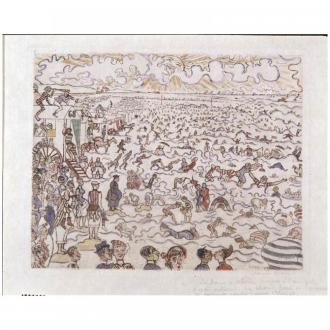In this coloured-in sketch, Ensor provides his impression of the bathers on the strand of Ostend. To the left stands a large number of bathing carriages, which one can hire and in which could then change clothes. After a carriage driver had hitched a horse to the coach, the wagon would be pulled out into the water and when it had arrived well and good and the stepladder was set out, the driver would rap the coach on the roof with his whip, as a sign that the vehicle could be vacated. Then, one could see the “ridiculous and deformed creatures” enter into the water with their striped bathing costumes. For many of the locals and visitors of Ostend, this was an amusing spectacle. Ensor had another take on the events. His friend, the literary figure André de Ridder, wrote how Ensor “united hundreds of these intruders, insulting the sea with their insidiousness and grotesqueness, into a lunatic dance of fools in the water”.
This archived website ‘James Ensor. An online museum.’ is temporarily not being updated. Certain functionality (e.g. specific searches in the collection) may no longer be available. News updates about James Ensor will appear on vlaamsekunstcollectie.be. Questions about this website? Please contact us at info@vlaamsekunstcollectie.be.







